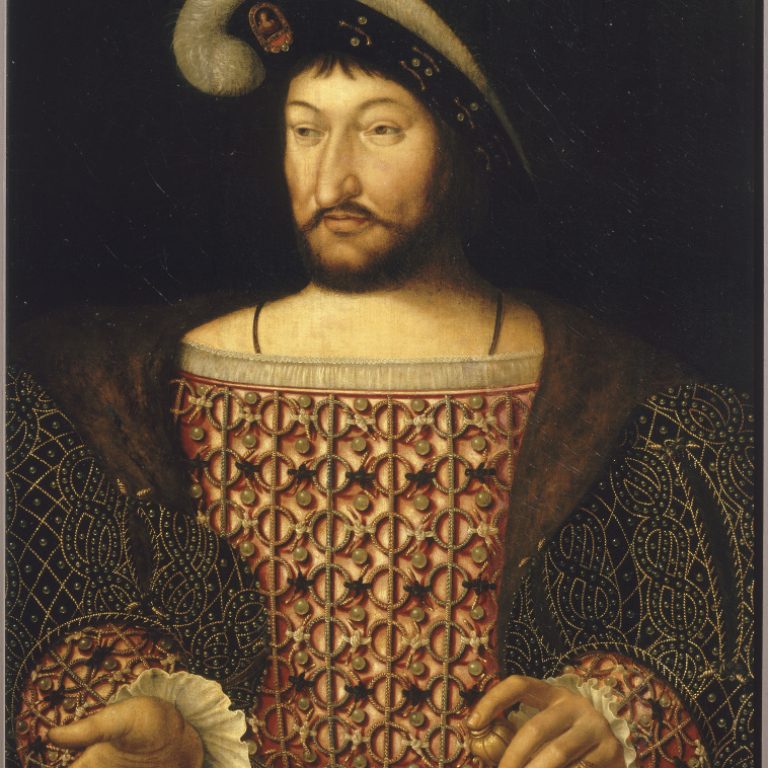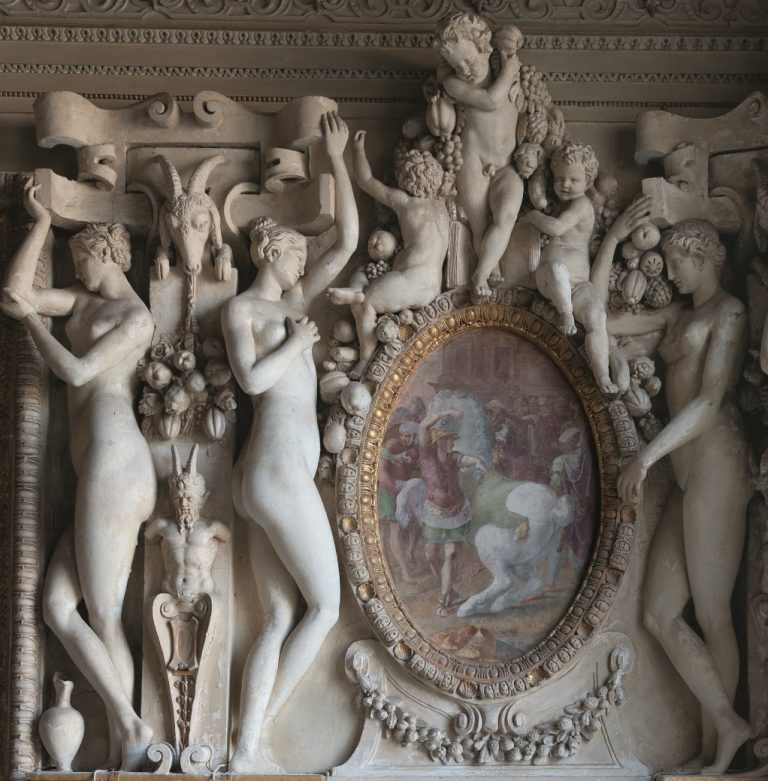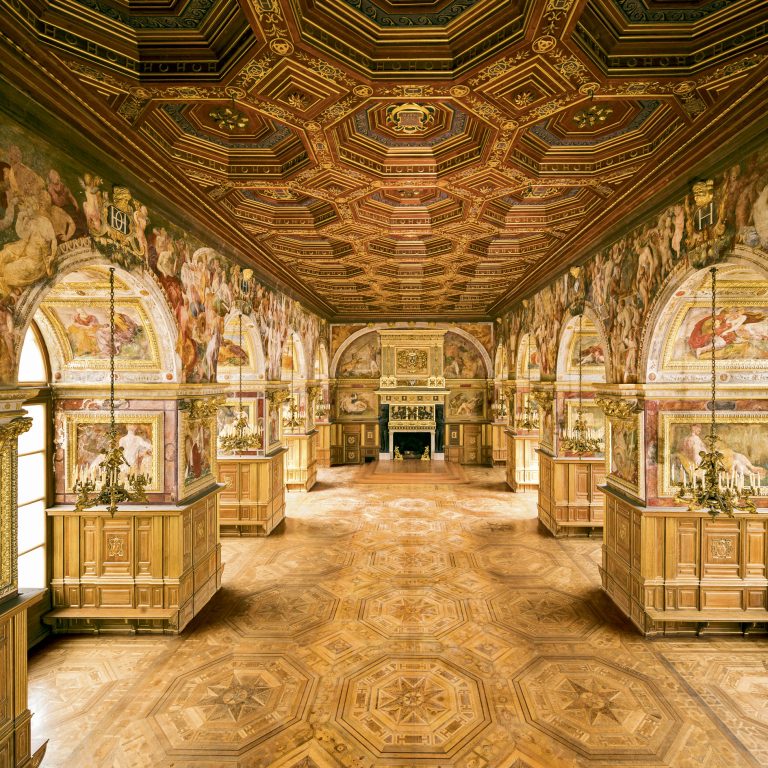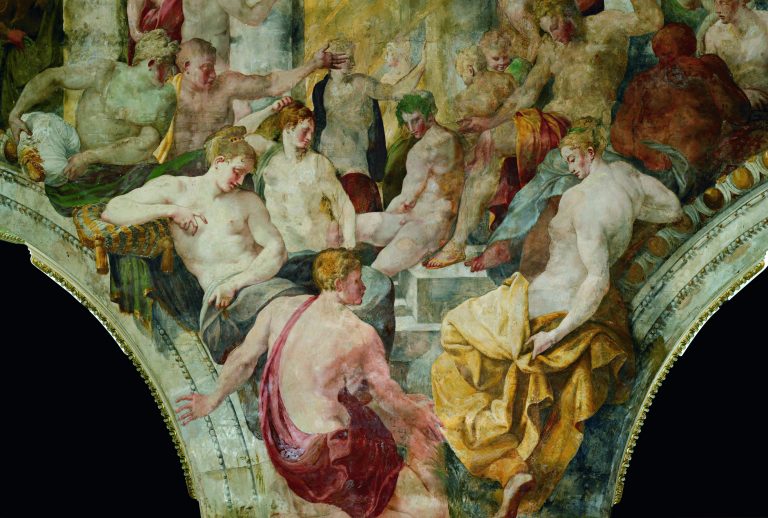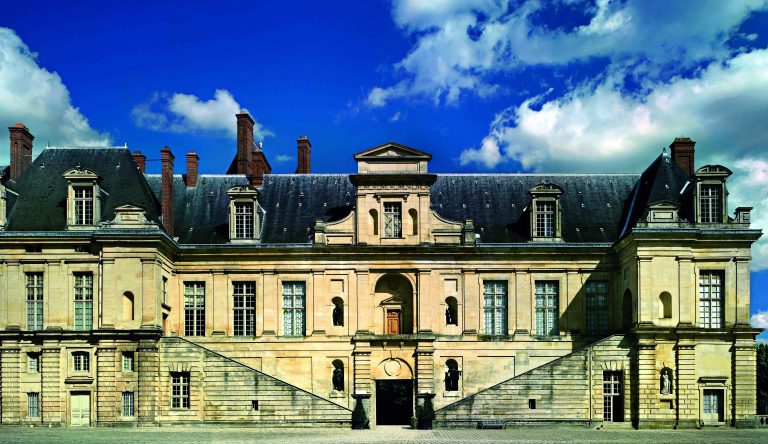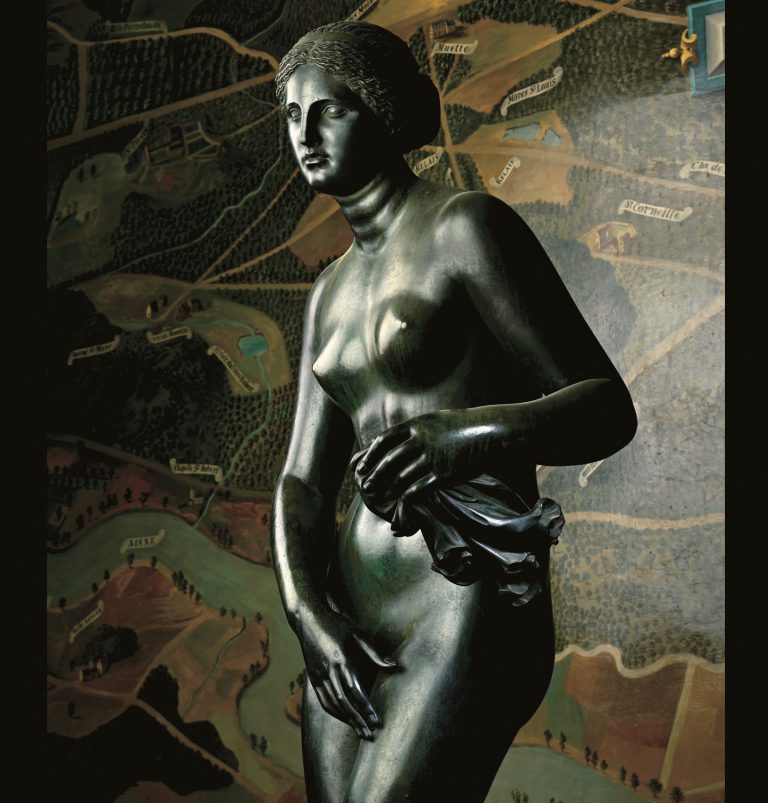A ‘new Rome’
The year 1527 was the real second birth of the castle. In that year, Francis I ordered the old castle in the oval courtyard, whose buildings had fallen into ruin, to be renovated and almost completely rebuilt on the original foundations. Only the keep was preserved, pierced with large windows and covered with a high roof. On the site of the old medieval gate, a new monumental entrance was built, the Golden Gate, whose superimposed vaulted loggias were based on a much more ‘skilful’ conception of layout. The medieval Chapel of St Saturnin was also completely rebuilt according to a two-storey plan.
The building site became more and more ambitious, attesting to the king’s growing interest in Fontainebleau: as early as 1528, work began on the construction of the Francis I Gallery, which was to change the castle’s appearance forever. Adjacent to the King’s apartment, whose chambers were located on the first floor of the keep, it formed a covered passage between the keep and the church of the Trinitarian convent to the west.
It is said that the king himself kept the key to this gallery, the first of his generation, around his neck and that he only allowed his distinguished guests to visit it. In the 1530s, the Florentine painter Rosso Fiorentino was entrusted with designing the interior decoration, which was totally new in France, using allegorical language as well as texts from ancient history and mythology. Rosso initiated, in the service of the royal majesty, the mannerist formulas that he had developed in Italy and which were to make Fontainebleau famous. In his footsteps, in 1532, arrived the young Primaticcio in Fontainebleau, to whom the king commissioned many décors, including those for the chamber of his powerful favourite: the Duchess of Etampes. It was also Primaticcio who worked, on the ground floor of the gallery, on the décor of the bathhouse apartment in which Francis I exhibited precious paintings such as Leonardo da Vinci’s The Mona Lisa or The Virgin of the Rocks. Fontainebleau, a castle of springs, was home to a royal library which, under the authority of the philosopher Guillaume Budé, brought together ancient Greek and Latin literary ‘founts’ that nourished royal humanism.
As early as 1537, an ambitious architectural project began to definitively eliminate the old medieval convent to the west: the construction of a ‘large lower courtyard’ with a vast even layout (today’s Court of Honour), inspired by Italian architecture, propelled Fontainebleau to one of the most ambitious projects of its time. This extension to the castle went hand in hand with the king’s new interest in his garden ‘du clos de l’étang’, laid out to the west of the carp pond (where the English garden now stands). This garden featured the famous Belle Eau fountain, the founding site of the estate, which was the subject of a monumental treatment. In the castle’s décor, homage was paid to the famous ‘nymph’ of the site, the tutelary deity of this spring, and to the hunting dog Bléaud who, according to the legend that was appreciated by the sovereigns, was responsible for its discovery.
Although Francis I received the many ambassadors of the European courts in Fontainebleau, giving them the impression of walking the corridors and gardens of a ‘new Rome’, it was the visit of Emperor Charles V on Christmas Day in 1539 that most clearly demonstrated the importance of a castle that had become ‘the house of the king’.
The main residence of the Valois
‘If you worry too much about getting things done, you will never get anything done’, said Francis I. And indeed, at the time of the king’s death in 1547, Fontainebleau was still under construction: the Chapel of the Trinity had been partially rebuilt, but the roof and interior design were still missing, while on the first floor of the oval courtyard, the architectural project of a large loggia topped by a roof terrace was only just beginning. The completion of the building site then fell to his heir, Henry II. Relying on his architect Philibert Delorme, the sovereign set about continuing the great unfinished work. In 1551, the roof of the church was laid, while a choir enclosure and a box for the sovereigns were installed. The original plan for the great loggia was altered: it was transformed into a vast hall that could provide a suitable setting for the festivities and solemnities of the court. The Italian joiner Scibec de Carpi gave it a sumptuous coffered ceiling, and it became the ‘great ballroom’ of the castle, immediately frescoed by Niccolo Dell’Abate, based on Primaticcio’s drawings.
During his reign, Henry II stayed in Fontainebleau just as regularly as his father and continued the ambitious project of making it the main residence of the monarchy. At the very end of his reign, the king witnessed the construction of a first horseshoe staircase in the ‘Great Lower Courtyard’, providing new access to the apartments on the first floor. The old oval courtyard, which was uneven and narrow, began to lose its status as the main courtyard in favour of its vast, even, younger part, which was to become, following the installation of a plaster horse in its centre, ‘The White Horse Courtyard’. It was in this ‘house of legitimacy’ that six of the children Catherine de Medici gave to the king were born, including the future Francis II (19 January 1544) and Henry III (19 September 1551).
On the death of Henry II in 1559, his widow Catherine de Medici revealed her love of building and construction. Disgracing Philibert Delorme, she entrusted the Fontainebleau building site to a 55-year-old Primaticcio, who was promoted to the position of Chief Authorising Officer of the buildings, décor and festivities of the castle. Under the troubled skies of the Wars of Religion, the Italian created the last scenographies of a French Renaissance that had reached full maturity…
Fontainebleau tested by the Wars of Religion
‘And when will we again see, through all Fontainebleau/from room to room, the masquerades?’. These verses by Pierre de Ronsard seem to yearn for the golden age of a castle without walls or moats, entirely devoted to court festivities and pleasures. In 1564, while the Wars of Religion were tearing the Kingdom apart, Catherine de Medici staged a carnival at the castle with the aim of reconciling Catholics and Protestants around the young King Charles IX.
While this week of festivities marked a particularly enchanting theatrical interlude in the violence of the civil wars, in 1565 a moat had to be dug around the castle and armed with a drawbridge to counter any possible attack on the king. The presence of this moat, which was to remain until the French Revolution, had consequences on the future development of the palace. The entrance to the royal residence would, from then on, be via the drawbridge in the White Horse Courtyard, following a route leading directly to the Fountain Courtyard.
As a result, the reign of the young Charles IX was marked, until 1570, by the last major works that signalled the maturity of the Renaissance: in the Fountain Courtyard, which until then had been lined with buildings of varying styles, Primaticcio had the wing of a building built around two diverging sets of stairs that gave access to the king’s new apartment: the Beautiful Fireplace Wing. The Italian had the famous bronzes he had made for Francis I 30 years earlier placed in the niches of this great classical composition. At the same time, in the White Horse Courtyard, the décor of the ‘Great Gallery’ located on the first floor of the south wing was completed: the Ulysses Gallery. Begun in 1537 under the direction of Primaticcio, joined by Niccolo Dell’Abate, it would take over twenty years to complete his programme of 58 frescoes depicting, on its north and south walls, the odyssey of Ulysses, the moral model of the kings.
The Age of the Valois thus ended in sumptuous twilight. With the worsening of the Wars of Religion, Fontainebleau was to endure a second crossing of the desert: forsaken by Henry III, the last grandson of Francis I, the state of the castle and the gardens deteriorated in a spectacular fashion: ‘Now everything is falling into ruin: the beautiful lake at the foot of the gallery is almost entirely filled in and the gardens themselves are in a state of disarray’, noted the Venetian ambassador Girolamo Lippomano in 1577.
